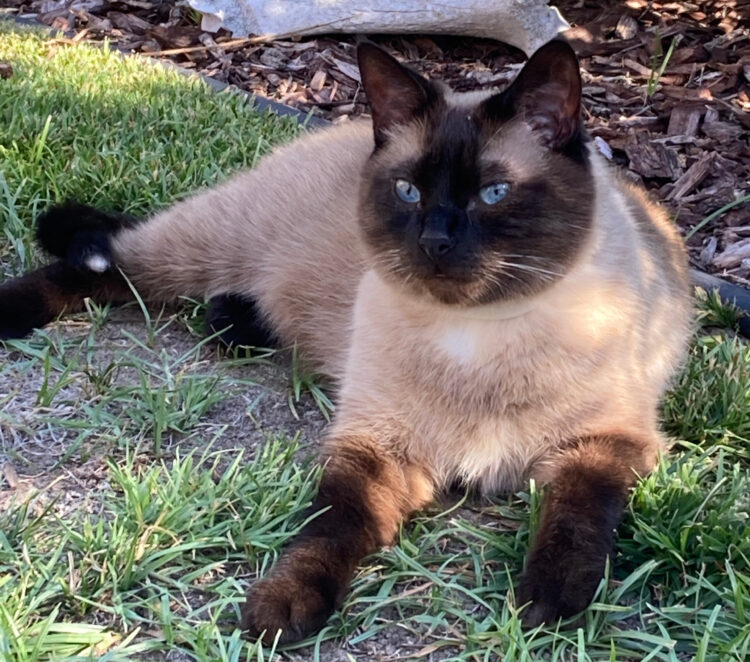
Guest post by Ingrid R. Niesman MS, PhD
During the first few months of 2022, I had two apparently healthy and happy Siamese boys. Until I didn’t.
Uli was diagnosed with asthma in January. Click here to read The Challenges of Treating Feline Asthma for his story. Then in March, heartbreak struck again when I lost Big boy Paterson. Click here to read Losing a Cat to Aggressive Lymphoma Highlights the Need for Better Diagnostics and Treatment.
This is the third part in my series about important feline topics, seen through my own experiences in 2022.
A quest to fill the void
Grief is complex. After our memorial in our backyard garden for Paterson, the house seemed too big for just one Siamese cat and two adults. Some people internalize their anguish. I turn mine into action; not always the best choice as you will see.
Research from 2015 shows that like many other potential adopters, I began my search on-line (Workman, 2015). Just browse, I told myself. It will take a long time to find an appropriate Siamese companion for Uli, I thought. When Paterson came home, he and Uli bonded immediately. I knew Uli would suffer, being an only cat.
Within a few days, an age-matched Siamese popped up in my email. He had been at the shelter for almost two months and was in danger of health issues due to stress on the adoption floor and a lack of eating.
Siamese typically do not fare well in shelter environments. Their normally gregarious nature is suppressed, and they hide in the back of cages. On a positive note, many adopters are looking for purebreds, and if they aren’t held too long in a shelter setting, they tend to be adopted quickly. Here in California, we are fortunate to have a dedicated Siamese Rescue that pulls adoptable cats from high-kill facilities, fosters them to get good histories and is very successful in placing cats in loving homes. Paterson benefited when we adopted him from this organization.
I wrote the municipal shelter to get some background on their cat before I arranged a visit. Was he screened for FIV? How did he end up at the shelter?
Ragging on people is outside of my article’s scope, but this beautiful boy was dumped in a mall parking lot in a cat carrier alongside another cat on a hot day! Fortunately, the shelter was close by and was quickly notified by kinder humans. The vet tech at the shelter thought the two cats had lived together, but they never interacted in the adoption area.
So, the only real question about his history was how he interacted with other cats. We were entering murky waters there.
A better approach for adoption
Cats in shelters lead tenuous lives. Sadly, estimates are that up to 70% never leave alive. Many are adopted and then returned. There are two major factors at play in this dynamic: selecting a cat based on physical appearance and perceived temperament only to be disappointed at home, and unrealistic expectations for a cat’s adaptation to a novel environment.
The ASPCA developed a shelter program, Meet Your Match (MRM®,) aimed at identifying accurate information about a cat’s future in-home behaviors with the perfect cat companion. Feline-ality™ is an assessment performed at one to three days post intake. Scores from shy to bold and independent to gregarious are broken down into a matrix, and cats are assigned to one of nine possible personalities. I don’t know who was responsible for the category names, but they are genius.
- Private investigator
- Secret admirer
- Love bug
- Executive
- Sidekick (definitely Uli)
- Personal assistant
- MVP (Paterson)
- Party animal
- Leader of the band
Not only are cats assessed, but adopters fill out a questionnaire about how they envision a cat in their lives. Do they expect a cat that cuddles? Do they want a cat that is good with small children? Adoption counselors are then better able to advise potential pet parents on their feline selections by predicting future in-home behavior.
Shelters that have implemented this program are finding increased successful adoptions, fewer returned cats, and decreased need for euthanasia (Weiss, 2015). The downside is that the resources needed to use these tools are frequently limited in shelters.
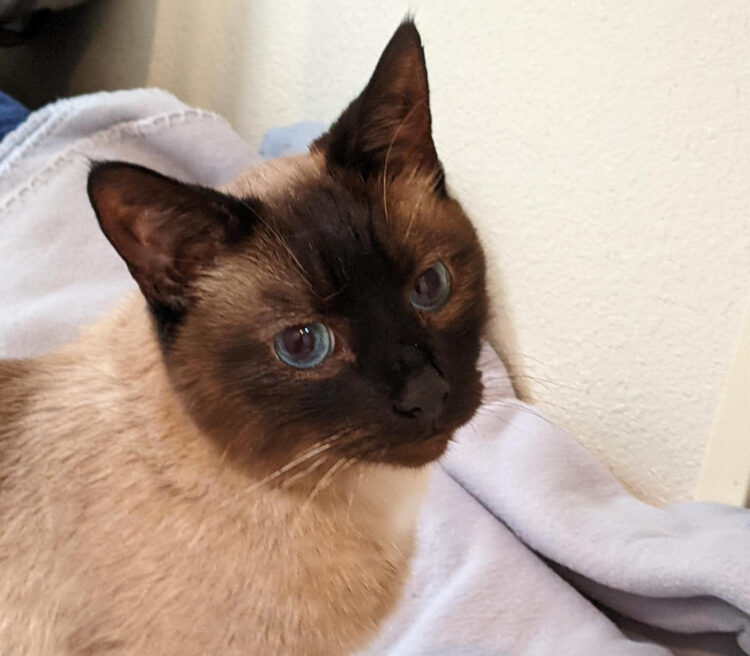
How valuable are observational assessments?
A newly published 2023 study (Darling, 2023) explored alternative options to full implementation of Feline-ality. First, these authors looked at the standard Feline-ality persona compared to just using age, sex, and coloration for assessments. They found very little correlation.
Interestingly, next, they used a human personality survey, the IAS-R (Interpersonal Adjective Scales, Revised), capturing two important personality dimensions for categorizing each cat: the dominance-submission spectrum, and the love-hostility spectrum. Not surprisingly, using a human personality survey instrument did not capture the complete picture of feline personality. There was a weak correlation between the IAS-R dominance axis and the Feline-ality independence axis, but little else.
“Personality is important in relationships being successful between humans and pets,” states lead author Saethra Darling, Ph.D. postdoctoral scholar at Oregon State University’s Human-Animal Interaction Lab. Her work is laying the groundwork for future tools investigating a more complete picture of feline-human interactions. “There is so much at stake,” she says. “Animals’ lives are in the balance.” She believes that no current instruments that subjectively measure feline behavior are successful in real world implementation, and dependency on these tools may backfire and result in continued high levels of euthanasia.
Further, as Dr. Darling points out, no current tools can accurately predict inter-cat aggression, a key factor I needed as I was moving on to our next steps.
Confirmational Bias – I love Siamese
The shelter holding my potential new Siamese friend arranged a visit with us on the Friday before Memorial Day weekend. Before our visit, we were told that Bashful was a work in progress. He had lost weight and they had pulled him from the floor. Best consider a fostering situation, we were told. Getting him out the shelter even just for a long weekend seemed like the kind thing to do.
Although this shelter didn’t employ Feline-ality, they did have a good grasp on feline care and assessment. We met Bashful in his cage. He was shy but let me pick him up and pet him. Obviously, he had been someone’s pet. He still wore a bedazzled cat collar, which I suspect was selected by a young girl. He needed to be back in a real home with love once again. We took him as a foster that day.
An introduction gone sideways
Guidelines for successful cat introductions are easily found. Isolate in a quiet area with typical cat resources, don’t let other cats see the newcomer, avoid letting them into areas with “unders” for hiding, and provide love and attention when the newcomer is calm. Take your time, let the resident cat find where the new guy is occupying space.
I’m not a newbie to cat introductions. My first Siamese, Turbo, self-introduced with the next-door neighbor ginger, OJ. It was love at first sight. She wrangled with a sister for a few days, but they became companions, if not bonded. Izzy rapidly accepted the kitten Spock later. And of course, Uli and Paterson were only separated for a few days while Uli sat by the door. Again, it was love and bonding at first sight.
However, I was ill-prepared for the following month of chaos.
The first night Bashful settled into our laundry room. He finally ate some real food and used the litter box. So far so good, I thought. Uli came by the door to sniff without hissing.
The next day, I shut Uli in our bedroom so Bashful could explore parts of our downstairs. He was hesitant at first, but walked quietly around checking out the scene. Then he disappeared. I finally found him tucked into a closet. Extracting him proved difficult and stressed us all. I put him into our bathroom overnight, where hiding places didn’t exist, with pheromones and soft blankets to try and calm him down.
After a few days, we gave him extra space and thought we had blocked off access. Unfortunately, Uli and Bashful had declared war. The worst part was that Bashful used spraying as a weapon. He would chase Uli on sight, pin him and spray on top of him. I am still shocked at this behavior. Otherwise, he was a super sweet rascal of a cat with humans.
After a long and difficult week of total separation, with Uli upstairs and Bashful living downstairs to avoid seeing each other, they met again. This time, both Uli and Bashful peed all over the place.
Unfortunately, our fostering experience had to end for the sake of all involved. Both cats were experiencing extreme stress and anxiety. Permanently dividing our home isn’t physically possible. Neither cat would endure a prolonged daily battle unscarred.
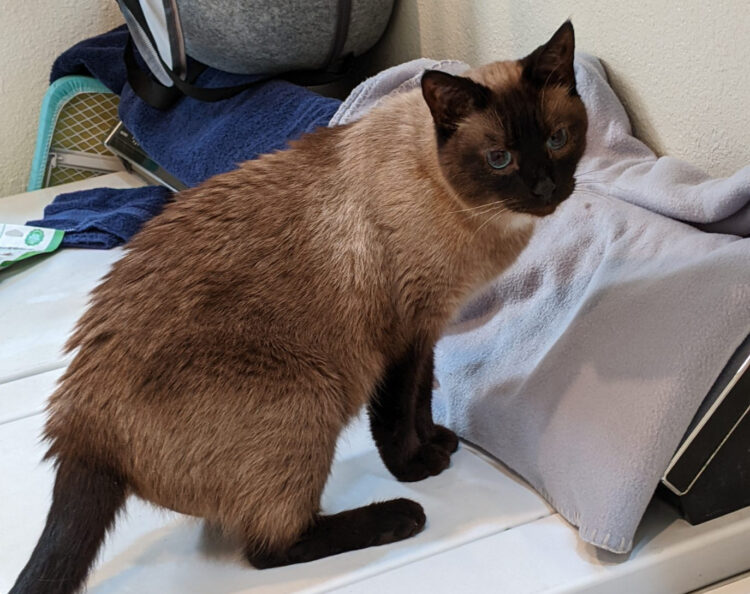
Human angst and feline stress with failed adoptions
Bashful was only just beginning to recover from his ordeal at the shelter. His coat was glowing. He had gained back a few pounds and his blood work had stabilized. Returning him to that environment was not an option for me. With the blessing of the shelter, I knew the only responsible option was to rehome Bashful.
In a recently published study looking at the factors related to returns in under 30 days, issues with the individual cat were cited as the top reasons for a quick turnaround by adopters (Mundschau, 2023). Malini Suchak, Ph,D., senior author of the study, explains “…our research suggests that a major reason for short term returns tends to be a mismatch between the cat and home.” This differs with returns after a lengthy period of time, which, according to Dr. Suchak, revolve around the cat parent’s situation, not the cat.
Besides the stress and anxiety returned cats feel, humans, too, are affected by the failed adoption, as previously published studies have reported. I was overwhelmed by a combination of grief and guilt. A 2022 study reports finding that unsuccessful adoptions can influence future willingness to try again (Powell, 2022). I haven’t given up on rescue adoptions but as future articles will show, I did choose a different route to a new friend.
Choices to make and directions to take
Clearly, it was not Bashful’s fault that he ended up in a shelter, and then in my house. I chose him. On the whole, he was a wonderful cat: sassy, active, yet loving to people, and adorable. I was convinced he’d make the right adopter very happy.
On a positive note, many of the cats returned to shelters are re-adopted. The unexplored role fostering may play is an important part in this phenomenon. Intriguingly, data support the idea that fewer cats are returned from foster-based adoptions. Once a cat is returned, the shelter can obtain a better house-history for each cat, creating a much better future match. More studies are badly needed to support this assumption. Although our situation went awry, I know we set up Bashful to find a loving home.
Use all your available resources to help find loving homes
Once the difficult decision was obvious for us, I turned to the same resource I had perused to first find Bashful: the internet. Using the most adorable photo possible, which wasn’t hard since he was a beautiful Siamese with a perfect touch of spunk, I listed him on as many local sites as I could.
Having had a better understanding of actually matching feline personality traits to human expectations like Feline-ality rankings would have been very helpful as I crafted my description. Apparently, according to a 2019 study, including toys and perhaps even including a short video clip is enticing to on-line cat searchers (Schenfeld-Tacher, 2019).
Bashful, meanwhile, sold himself.
A happy ending for all
Bashful found a lovely quiet home, where he is the single cat king. He is now leash trained and gets daily 30-45 minute walks in the California sunshine.
I still miss him but am feeling better about the situation, knowing my month of fostering him probably increased his chances for a better home.
If you can’t permanently adopt, please volunteer to try fostering from a shelter. Even a few days may save the life of one cat.
Photos ©Ingrid Niesman, used with permission
Ingrid R. Niesman MS PhD is the Director of the SDSU Electron Microscope Imaging Facility at San Diego State University. She graduated from Utah State University and received her MS from the University of Illinois-Urbana-Champaign. After 30 years of technical electron microscopy, cell biology, neuroscience and infectious disease research, Dr. Niesman completed her PhD in the UK at the University of Sunderland. Her work experience includes time at LSU Medical School, Washington University, UAMS in Little Rock, UCSD, TSRI and a postdoctoral year at CALIBR in La Jolla, CA. She has worked for at least two National Academy of Science members and is credited with over 50 publications. She can be reached at [email protected]
Articles Cited
Workman, M.K. and C.L. Hoffman, An Evaluation of the Role the Internet Site PetfinderPlays in Cat Adoptions. J Appl Anim Welf Sci, 2015. 18(4): p. 388-97.
Weiss, E., et al., Modification of the Feline-Ality Assessment and the Ability to Predict Adopted Cats’ Behaviors in Their New Homes. Animals (Basel), 2015. 5(1): p. 71-88.
Saethra Darling, J.H., The relationship between feline-ality, the interpersonal circumplex, and cat characteristics. Applied Animal Behaviour Science, 2023. 258: p. 105817.
Mundschau V., S., Malini, When and why cats are returned to shelters. Animals, 2023. 13: p. 243.
Powell, L., et al., The impact of returning a pet to the shelter on future animal adoptions. Sci Rep, 2022. 12(1): p. 1109.
Schoenfeld-Tacher, R., L.R. Kogan, and P.C. Carney, Perception of Cats: Assessing the Differences Between Videos and Still Pictures on Adoptability and Associated Characteristics. Front Vet Sci, 2019. 6: p. 87.






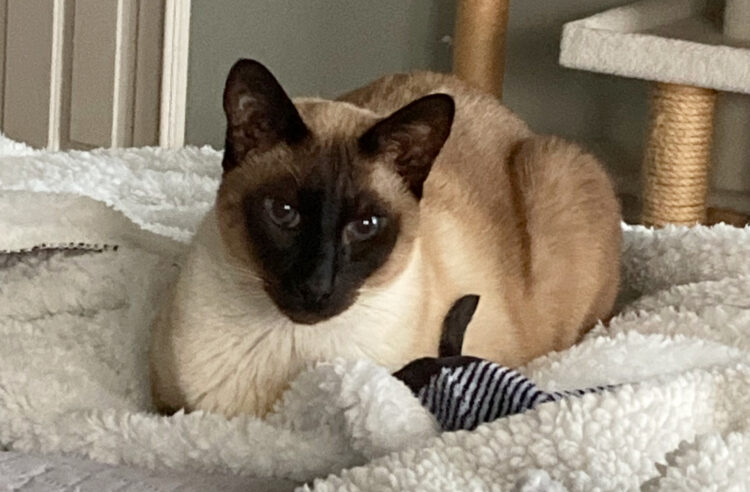
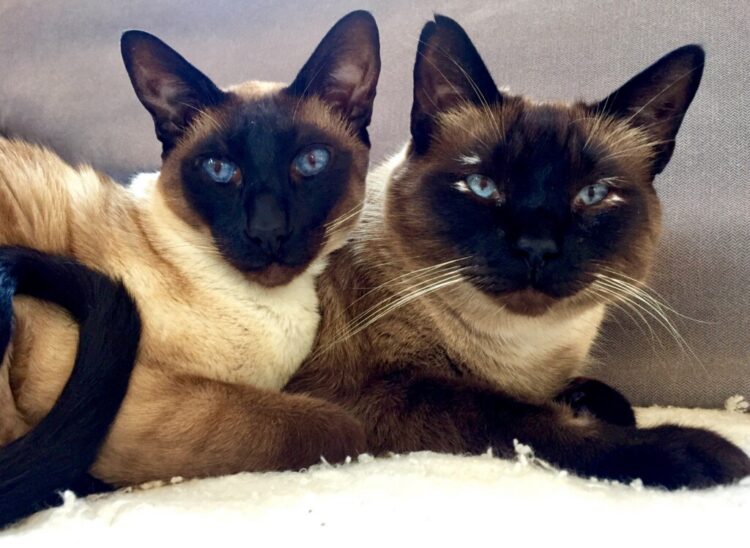
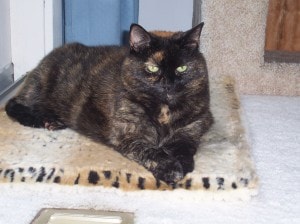
This story remids me of a Siamese we had found 40 years ago at our apartment complex. She was a sweet love that I named Summer. She had the most beautiful blue eyes.
Having volunteered for a cat rescue, it is hard to watch the cats come back. But in this case, there really wasn’t much of a choice if neither cat (and humans) would be happy. I’m glad Bashful found a home where he can rule on his own.
Beautiful cats I love all cats people have too realize when they are adopting cats from shelters they have too be very patience with their new family member for nobody knows what they went through before they hit the shelter. People say they don’t remember their past lives but I firmly believe they do remember. I have adopted several cats from shelters old and cats with disabilities takes awhile. I had one cat I adopted from the shelter don’t know what happened too her in her past but I was her third parent but she apparently never got over it for the only place I could interact with her was in the closet that where she would be fed and other things but she was a good cat.